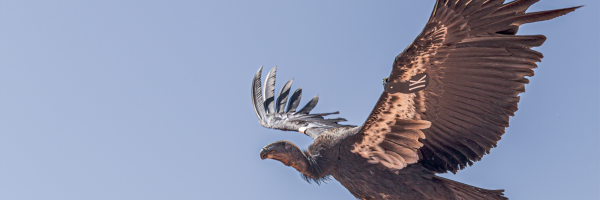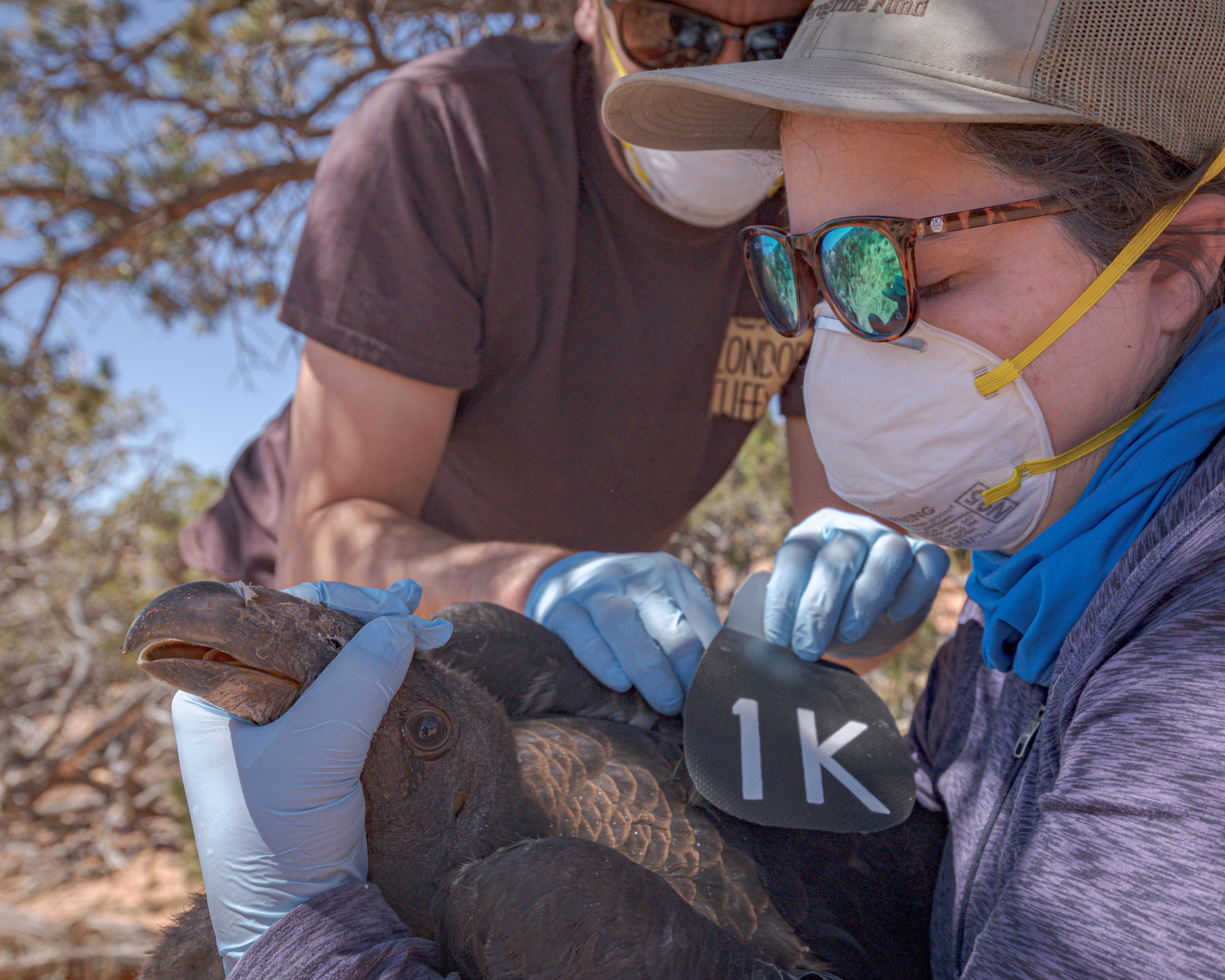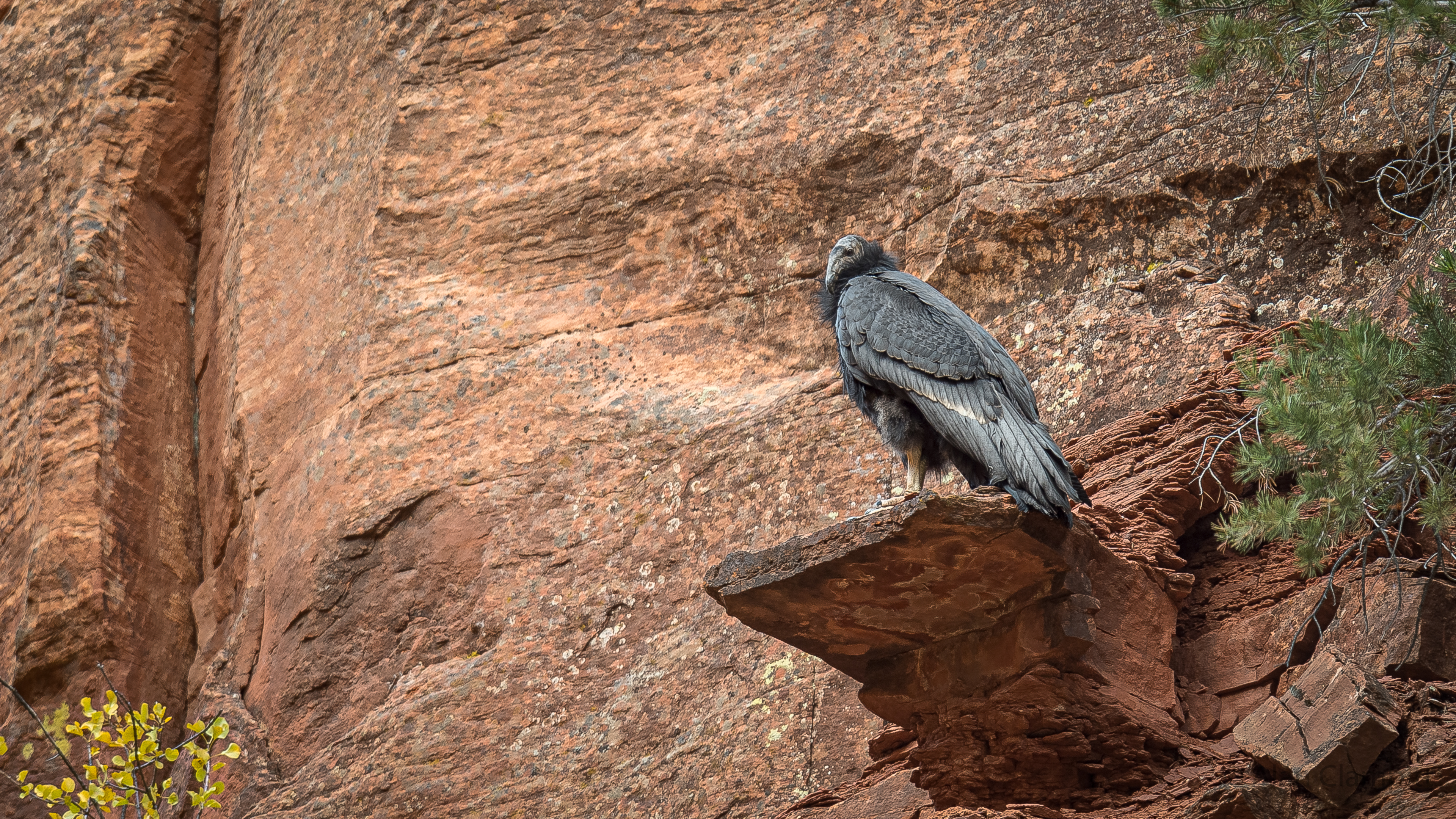© Alan Clampitt
The Peregrine Fund (TPF), U.S. Fish and Wildlife Service, and Zion National Park regret to announce the death of California Condor 1K.
The tagging of the 1,000th California Condor, known as “1K”, was a pivotal moment for the California Condor Recovery Program. Hatched in May 2019, 1K was the first condor to successfully fledge in Zion National Park. On May 21, 2020, the young condor was trapped and given an identifying tag of “1K”, officially marking him the 1,000th California Condor hatched since the start of the Recovery Program in the 1980s. His studbook number of 1000 signified a remarkable benchmark for the recovery effort, which began with only 22 condors in 1982. Since introducing 1K to the world, people have traveled to Zion National Park just to catch a glimpse of his impressive nine-and-a-half-foot wingspan. Merchandise and informative signs throughout the park were developed to celebrate 1K as a symbol of hope for the recovery of the species.
Each California Condor carries a radio tag, allowing biologists to carefully monitor their movements and locations. In early March 2024, these field tracking efforts revealed that 1K had stopped moving. Biologists traversed several miles through rugged terrain in a remote canyon to locate 1K and were devastated to find him dead. Necropsy results confirmed what the team had suspected as the cause of death: lead poisoning. 1K died just short of his fifth birthday.
“1K’s death is a tragedy because it was premature and preventable,” says TPF’s California Condor Program Manager Shawn Farry. “He was still in his awkward teenage years, with his head color starting to change from black to orange. He was only a year or two away from finding a life-long mate and becoming a breeder. Like all condors, 1K was charismatic, often goofy, making it difficult not to form an emotional attachment to him. He had a wonderful way of endearing staff and visitors to the condor and its story, and for that, he will be missed by so many who were lucky to catch a glimpse of 1K soaring through Zion Canyon.”
It is a tragedy all too common for California Condors range wide. Lead poisoning remains the number one cause of diagnosed fatalities, with just under 50% of diagnosed deaths attributed to lead poisoning since releases began in California in 1992. Lead poisoning can result in serious illness ranging from lethargy and weakness to paralysis of the digestive tract leading to the inability to process food and water. Most deaths from lead poisoning are a result of starvation and dehydration. Since the first release in Arizona in 1996, 52 California Condors in the Arizona-Utah population have died from lead poisoning, but the impact of lead on condors goes far beyond that–90% of condors trapped and tested during this past year had blood lead levels that indicated exposure.
One of those condors was 1K’s sibling, California Condor 1111. In 2021, just two years after 1K made history, 1111 became the second wild-fledged condor in Zion National Park. In January 2024, she was trapped and tested with other condors during routine trapping efforts. The team was astonished to find that she had the highest lead value recorded in a live bird in the program’s 28-year history. She was immediately transferred to Liberty Wildlife, a wildlife rehabilitation center and program partner, for treatment by their expert veterinary team. After a long road to recovery involving several months of intensive care, 1111 was released back into the wild on May 17, 2024, seemingly recovered from this event with lead. 1111’s story highlights the continued need to manage the condor flock while lead poisoning remains a threat to recovery.
California Condors are particularly vulnerable to lead poisoning because they are obligate scavengers meaning they are limited to feeding upon the remains of dead animals. When remains of shot animals like deer, elk, livestock, or other game species are left afield, scavengers will efficiently clean up those remains, which is a good thing. If, however, those remains contain fragments from lead-based ammunition, scavengers can unknowingly consume lead, become sickened, and sometimes die. While one feeding may not be enough to feel the impact, consuming lead fragments repeatedly can lead to a build-up in their system. Biologists have even documented lead in the blood of California Condor nestlings because of lead-laced meals brought to them by their parents.
Lead levels in California Condors are closely monitored and documented because of the vulnerable nature of their population. This information also provides valuable insight into how other species, such as Bald and Golden Eagles might be exposed through scavenging.
“The California Condor is an indicator species,” says TPF’s California Condor Program Director Tim Hauck. “We know that other scavengers are eating from the same carcasses as condors. In fact, it is not uncommon to see eagles feeding alongside condors. Since many of those species are not currently considered at risk of extinction, they are not as closely monitored as the condors. But they are being exposed to the same sources of lead and are likely experiencing some level of lead poisoning.”
In 2023, the California Condor Arizona-Utah population experienced an additional, unexpected tragedy: Highly Pathogenic Avian Influenza (HPAI). The outbreak killed 21 condors, and since then, the population has sustained an additional eight deaths due to lead poisoning with several other diagnoses still pending final necropsy results. While the Southwest monitoring team and remaining condors persevere, the outbreak reinforced the importance of focusing on preventable causes of mortality.
“We cannot predict or control disease outbreaks and natural disasters,” says Hauck. “We have to focus our efforts on the preventable causes of death to ensure inevitable, unforeseen causes won’t be the breaking point for the population and HPAI reminded us of that. The truth is lead poisoning is the number one cause of death for condors and a preventable one at that.”
In response to the preventable impact of lead poisoning on wildlife, TPF, the Oregon Zoo, and the Institute for Wildlife Studies co-founded the North American Non-lead Partnership (NANP). NANP aims to shape and facilitate efforts to minimize the threat of unintentional lead poisoning in wildlife through voluntary, incentive-based outreach and education programs while promoting ecosystem health, wildlife conservation values, and hunting heritage.
“We have come a long way in understanding lead pathways in wildlife and effectively collaborating with key partners like the Arizona Game and Fish Department and Utah Division of Wildlife Resources. Their programs have earned tremendous support from our fellow hunters, earning as much as 87% voluntary participation during the deer seasons,” says TPF’s CEO, President, and Co-founder of NANP Chris Parish. “Very simply, we must expand our reach to more hunters, managers, ranchers, sportsmen- and women. The proof is there. If people know and have alternatives, they are more than willing to help. We just need to reach them.”
Today, NANP has nearly fifty partners representing wildlife agencies, landowners, hunting products, and non-governmental organizations focused on hunting and science-based wildlife management. Each year, they expand their programs, reaching more hunters and spreading their mission to new regions. Hunters have been receptive to NANP’s message and are making the switch to lead-free ammunition or removing the remains of lead-shot animals from the field. With the hunting community leading the way, incidents like that of 1K’s death could be a thing of the past.
“1K’s death is a reminder that there is still work that needs to be done before we can take a step back and call this a conservation success story,” says Hauck. “The California Condor has experienced a difficult past year, but the trajectory of the program continues to move upward thanks to the resiliency of the condor and the hard work of so many in the recovery effort. And with the determination of the North American Non-lead Partnership, the California Condor Recovery Program, and countless partners, there is hope for the California Condor’s future.”








